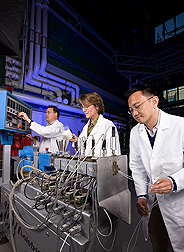Helping Earth-Friendly, Corn-Based Plastics Take the Heat
|
|
Those little plastic coffee-cup lids that keep your steaming hot java from sloshing all over you might someday be made from biodegradable, corn-based plastic. Making corn-derived plastics more heat-tolerant, so that they won’t distort when they’re not supposed to, is one of several top-priority targets of collaborative research under way since 2007 at the Agricultural Research Service’s Western Regional Research Center in Albany, California, near San Francisco.
Chemist William J. Orts, who leads the center’s Bioproduct Chemistry and Engineering Research Unit, works with collaborators Allison Flynn and Lennard F. Torres of Santa Barbara-based Lapol, LLC, to broaden the range of applications for which corn-based plastics would be ideal. The partnership, carried out under terms of a cooperative research and development agreement, aims at making those plastics an alluring alternative to petroleum-derived plastic goods.
Plastics made from corn are generally biodegradable, and corn is a renewable natural resource. While plastics made from petrochemicals can be biodegradable, they are derived from a finite, nonrenewable source.
What’s more, manufacture of corn plastics usually causes less pollution, including fewer greenhouse gas emissions, than does the production of petro plastics.
Corn-based plastics are made by fermenting corn sugar to produce lactic acid. In turn, the lactic acid is used to form a bioplastic known as “polylactic acid,” or PLA. Trouble is, PLA has a lower heat tolerance than some petroleum-based plastics. “That excludes PLA from being used for some applications,” says Flynn.
In the plastics industry, the upper limit of PLA’s heat tolerance, that is, the temperature at which it may begin to distort, is referred to as its “heat-deflection temperature.”
To overcome this obstacle, Flynn, Torres, and Orts are developing a new product. Known as a “heat deflection temperature modifier,” it can be blended with PLA to make PLA more heat tolerant. The modifier itself is more than 90 percent corn based and is fully biodegradable, according to Flynn.
Preliminary tests at the Albany lab indicate that, when blended with PLA, the modifier can raise PLA’s heat-deflection temperature by at least 50˚F. With further research and development, the heat modifier might make it possible for hundreds of products that currently can’t typically be made with PLA to one day be manufactured with this bioplastic.
The products of the future might include not only coffee-cup lids, but perhaps food or beverage bottles or other containers that are “hot-filled,” that is, filled at the food-manufacturing or beverage-bottling plant while the food or beverage is still hot from pasteurization. Examples might include, among other popular items, tomato catsup or some kinds of fruit juice. Today’s PLA typically can’t take the heat of hot-filling.
ARS and Lapol are currently seeking a patent for the invention.
“Right now, there are no commercially available heat-deflection temperature modifiers for PLA,” says Lapol chief operating officer Randall A. Smith. “It’s an emerging market.”
The encouraging preliminary results for the experimental heat-deflection temperature modifier suggest that new opportunities for PLA may indeed be heating up.—By Marcia Wood, Agricultural Research Service Information Staff.
This research is part of Quality and Utilization of Agricultural Products, an ARS national program (#306) described at www.nps.ars.usda.gov.
William J. Orts is with the USDA-ARS Western Regional Research Center, Bioproduct Chemistry and Engineering Research Unit, 800 Buchanan St., Albany, CA 94710; (510) 559-5730.
A Cornucopia of Corn-Based Products
Agricultural Research Service scientists are busily inventing new, ecologically sound products from corn for home and industry. Several articles published in previous issues of Agricultural Research (archived at ars.usda.gov/ar) will tell you more about their work.
• “From Lubricants to Packaging Materials: ARS Scientists Just Say ‘No’ to Petroleum,” September 2009
• “Corn: The Latest Glue Ingredient?” September 2009
• “Zein—A Corn Compound With Diverse Valuable Uses,” November/December 2008
• “Corn-Based Absorbent Dries Soggy Books,” May 2007
• “Corn: A New Ingredient for Detergents?” April 2007
• “Electroactive Bioplastics Flex Their Industrial Muscle,” December 2005
"Helping Earth-Friendly, Corn-Based Plastics Take the Heat" was published in the September 2010 issue of Agricultural Research magazine.







